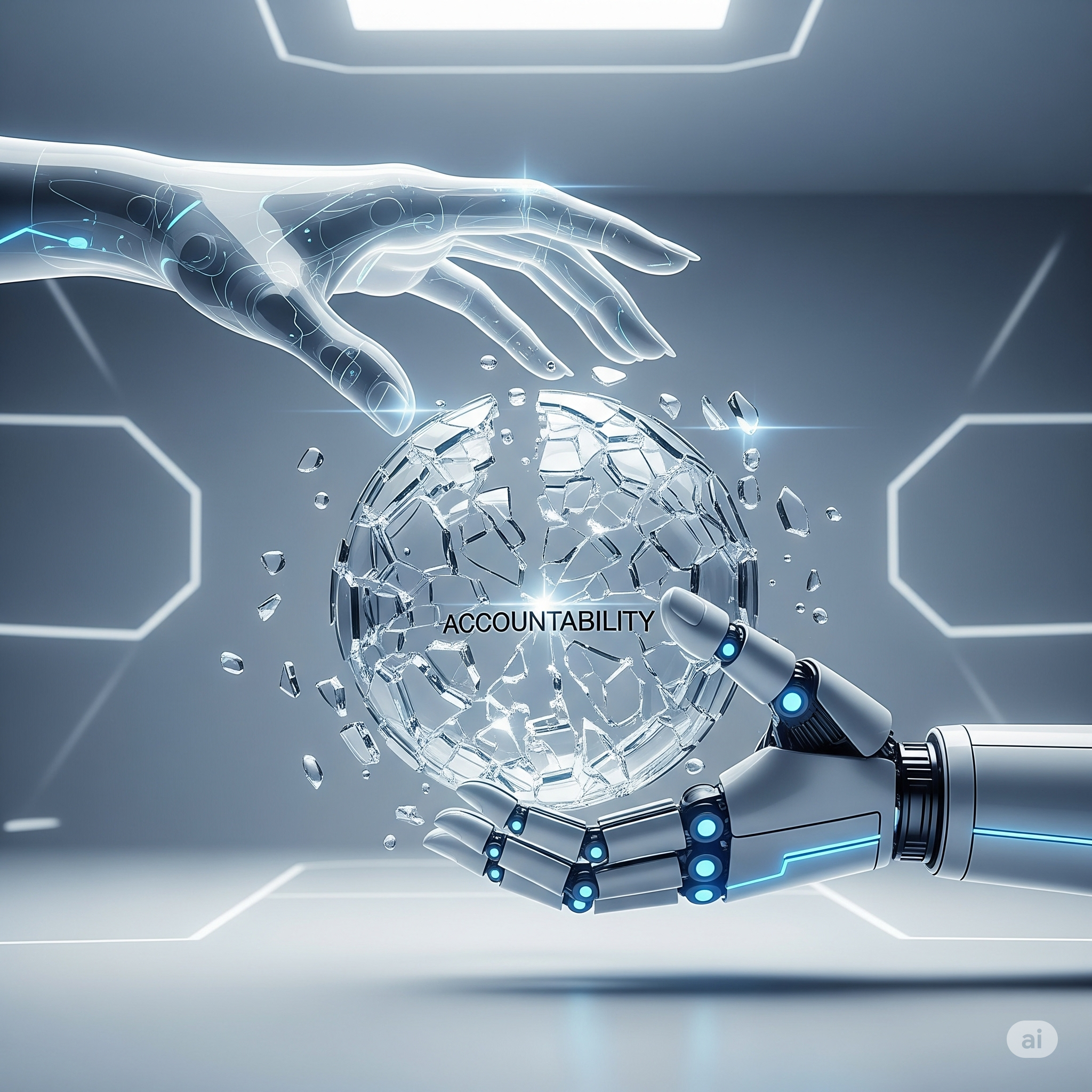The rise of artificial intelligence has brought us convenience, efficiency, and incredible innovation. But as AI systems become more autonomous—from self-driving cars to medical diagnostic tools—a crucial question emerges: Who’s responsible when AI gets it wrong? This isn’t a hypothetical dilemma; it’s a pressing legal and ethical challenge that is forcing us to rethink traditional concepts of liability, negligence, and accountability in a world where a non-human entity can cause harm.
The Problem of the “Black Box”
The fundamental challenge in assigning blame to AI is what experts call the “black box problem.” Many advanced AI systems, particularly those using deep learning, operate in a way that even their creators can’t fully explain. The algorithm learns by finding its own complex patterns in vast datasets, and its decision-making process is inscrutable to humans.
This opacity breaks traditional legal frameworks. If an AI system makes a critical error—say, a self-driving car swerves into oncoming traffic—it’s incredibly difficult to trace the fault back to a specific line of code, a piece of data, or a human decision. This creates an “accountability gap” where an error occurs, but no one is clearly at fault.
Applying Old Laws to New Tech
Today’s legal systems were not designed for autonomous, learning machines. Lawyers and courts are struggling to apply existing concepts like product liability and negligence to AI failures.
- Product Liability: This law holds manufacturers strictly liable for injuries caused by a defective product. The challenge with AI is twofold: first, is a piece of non-embedded software considered a “product”? And second, what constitutes a “defect” in a system that constantly learns and changes? The EU is currently revising its Product Liability Directive to address this gap, seeking to place greater responsibility on AI providers.
- Negligence: To prove negligence, one must show that a party had a duty of care, breached that duty, and that the breach directly caused harm. When an AI is involved, it’s hard to prove a developer or operator was negligent if they couldn’t have reasonably predicted the AI’s error.
Case Studies: Where AI Has Gone Wrong
The question of responsibility is no longer theoretical. Real-world incidents and lawsuits are forcing the issue into the courtroom.
- Self-Driving Cars: This is the most prominent example. In accidents involving autonomous vehicles, multiple parties could be held responsible:
- The Manufacturer: For a defective sensor or a flawed design.
- The Software Developer: For an algorithm that failed to make the correct decision.
- The Human Operator: For failing to take over control when a system malfunctioned. Some manufacturers, like Mercedes-Benz, are taking a proactive approach, publicly accepting liability for accidents that occur when their autonomous features are engaged.
- Legal AI “Hallucinations”: A more recent and telling example comes from the legal profession. Several lawyers have been fined by courts for submitting fabricated legal cases and citations that were generated by AI chatbots. The AI “hallucinated” these cases, and the lawyers failed to verify them. In these instances, the courts were clear: while the AI made the error, the human user remains responsible for verifying the output and ensuring the work is accurate.
The Answer: A Shift to Responsible AI
The legal and ethical solution to the accountability gap is not to abandon AI but to build a new framework around the concept of “Responsible AI.” This involves a multi-pronged approach that includes technical, ethical, and legal solutions.
- Explainable AI (XAI): This technical field aims to solve the “black box” problem by developing AI systems whose decisions can be understood and explained by humans. By making the AI’s reasoning transparent, it becomes possible to audit its processes and identify the source of an error.
- Accountability-by-Design: This principle states that accountability should be built into the AI system from its inception. Every step of the process—from data collection to deployment—should be traceable and have a clear, human point of responsibility.
- New Legislation and Policy: Lawmakers worldwide are working on new regulations to address AI. The EU’s AI Act, for example, places strict liability on providers of “high-risk” AI systems, shifting the burden of proof from the injured party to the developer.
Who is Responsible? The Distributed Liability
Ultimately, the responsibility for an AI error will likely be shared among several parties, a concept known as distributed liability. When AI gets it wrong, a claim could be made against:
- The Developer: For flawed code or insufficient testing.
- The Manufacturer: For a hardware defect or a lack of safety mechanisms.
- The Data Provider: If the training data was biased or corrupted, leading to the error.
- The Deployer/Operator: For misusing the AI, failing to provide adequate oversight, or not verifying its output.
The future of accountability won’t be about assigning fault to a machine, but about identifying the human or organization in the chain of command that failed to prevent the error.
FAQ Section
Q1: What is the “black box problem” in AI? A: It refers to the inability to understand how complex AI models, like deep neural networks, arrive at a specific decision or output, making it difficult to debug or assign blame.
Q2: Will AI ever be legally responsible for its own actions? A: No, in today’s legal frameworks, AI is considered a tool, not a legal entity. A human or organization will always be held responsible for the AI’s actions.
Q3: How is a self-driving car accident different from a normal car accident? A: In a normal accident, the driver is almost always at fault. In an AI-driven car accident, the liability is much more complex, potentially involving the vehicle manufacturer, the software company, or the human passenger.
Q4: What is the role of Explainable AI (XAI) in legal responsibility? A: XAI aims to make an AI’s decisions transparent. By understanding why an AI made a mistake, it becomes much easier for courts to determine who in the development or deployment chain is responsible.
Q5: What is “distributed liability”? A: It’s a legal concept where responsibility for an error or harm is shared among multiple parties who contributed to the outcome, such as the AI developer, the hardware manufacturer, and the user.
Q6: Why are lawyers being fined for using AI? A: Lawyers have been fined for submitting court documents with fabricated cases generated by AI chatbots. The fines were for the lawyers’ failure to verify the AI’s output, a core professional responsibility.
Q7: Is it possible for AI to be biased? A: Yes. AI models can learn and amplify biases present in their training data. This can lead to unfair or discriminatory outcomes in areas like hiring, lending, or criminal justice.
Q8: What is the EU AI Act’s role in all of this? A: The EU AI Act is a major piece of legislation that places strict liability on developers of high-risk AI, forcing them to take on greater responsibility for their systems’ safety and transparency.
Conclusion
As AI becomes more integrated into our lives, the question of accountability becomes more urgent. While AI promises incredible benefits, it also introduces a fundamental legal dilemma that traditional laws are ill-equipped to handle. The solution lies not in finding a single responsible party, but in creating a new legal and ethical framework that accounts for the complexity of AI systems. By focusing on Explainable AI, distributed liability, and robust regulation, we can ensure that as AI grows more powerful, our ability to hold its creators and users accountable grows with it.
SEO & Technical Suggestions
- Primary Keyword: Who’s Responsible When AI Gets It Wrong
- Secondary Keywords: AI liability, AI ethics, AI accountability, self-driving car liability, algorithmic bias, AI legal responsibility, Explainable AI, product liability and AI.
- Schema Markup Suggestions: Use
ArticleorBlogPostingschema. UseFAQPageschema for the FAQ section. - Internal Link Suggestions: Link to a previous article on AI and ethics, the future of AI in law, or a general piece on AI’s impact on society.
- External Link Suggestions: Link to reputable sources like the Electronic Privacy Information Center (EPIC), the EU’s official website for the AI Act, or legal review articles on the topic.
- Featured Image Suggestion: An artistic and conceptual image. Two stylized, ghostly hands—one human, one robotic—are clasped over a shattered glass sphere. The sphere represents “accountability,” and its broken state symbolizes the challenge of assigning blame when AI makes a mistake. The background is a stark, clean, futuristic space, emphasizing the complexity of the issue.





